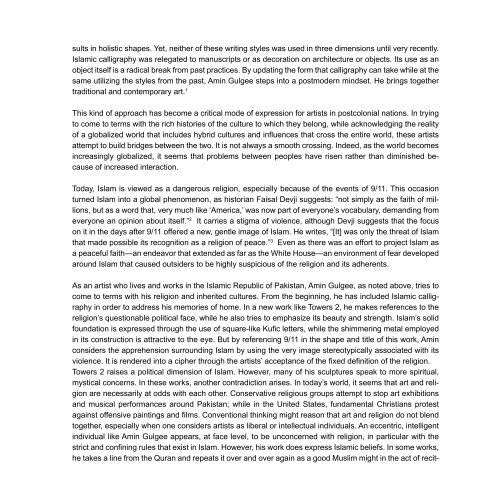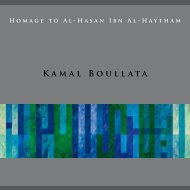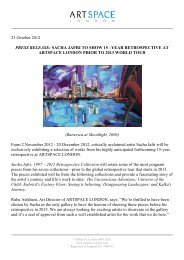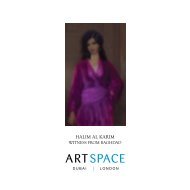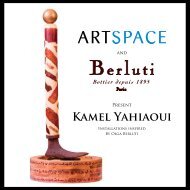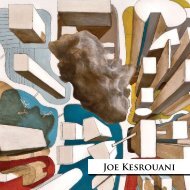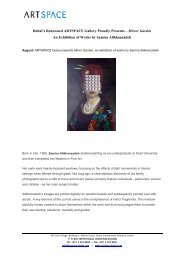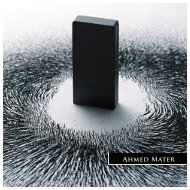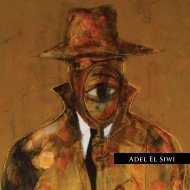Amin Gulgee
Amin Gulgee - Artspace Dubai
Amin Gulgee - Artspace Dubai
You also want an ePaper? Increase the reach of your titles
YUMPU automatically turns print PDFs into web optimized ePapers that Google loves.
sults in holistic shapes. Yet, neither of these writing styles was used in three dimensions until very recently.<br />
Islamic calligraphy was relegated to manuscripts or as decoration on architecture or objects. Its use as an<br />
object itself is a radical break from past practices. By updating the form that calligraphy can take while at the<br />
same utilizing the styles from the past, <strong>Amin</strong> <strong>Gulgee</strong> steps into a postmodern mindset. He brings together<br />
traditional and contemporary art. 1<br />
This kind of approach has become a critical mode of expression for artists in postcolonial nations. In trying<br />
to come to terms with the rich histories of the culture to which they belong, while acknowledging the reality<br />
of a globalized world that includes hybrid cultures and influences that cross the entire world, these artists<br />
attempt to build bridges between the two. It is not always a smooth crossing. Indeed, as the world becomes<br />
increasingly globalized, it seems that problems between peoples have risen rather than diminished because<br />
of increased interaction.<br />
Today, Islam is viewed as a dangerous religion, especially because of the events of 9/11. This occasion<br />
turned Islam into a global phenomenon, as historian Faisal Devji suggests: “not simply as the faith of millions,<br />
but as a word that, very much like ‘America,’ was now part of everyone’s vocabulary, demanding from<br />
everyone an opinion about itself.” 2 It carries a stigma of violence, although Devji suggests that the focus<br />
on it in the days after 9/11 offered a new, gentle image of Islam. He writes, “[It] was only the threat of Islam<br />
that made possible its recognition as a religion of peace.” 3 Even as there was an effort to project Islam as<br />
a peaceful faith—an endeavor that extended as far as the White House—an environment of fear developed<br />
around Islam that caused outsiders to be highly suspicious of the religion and its adherents.<br />
As an artist who lives and works in the Islamic Republic of Pakistan, <strong>Amin</strong> <strong>Gulgee</strong>, as noted above, tries to<br />
come to terms with his religion and inherited cultures. From the beginning, he has included Islamic calligraphy<br />
in order to address his memories of home. In a new work like Towers 2, he makes references to the<br />
religion’s questionable political face, while he also tries to emphasize its beauty and strength. Islam’s solid<br />
foundation is expressed through the use of square-like Kufic letters, while the shimmering metal employed<br />
in its construction is attractive to the eye. But by referencing 9/11 in the shape and title of this work, <strong>Amin</strong><br />
considers the apprehension surrounding Islam by using the very image stereotypically associated with its<br />
violence. It is rendered into a cipher through the artists’ acceptance of the fixed definition of the religion.<br />
Towers 2 raises a political dimension of Islam. However, many of his sculptures speak to more spiritual,<br />
mystical concerns. In these works, another contradiction arises. In today’s world, it seems that art and religion<br />
are necessarily at odds with each other. Conservative religious groups attempt to stop art exhibitions<br />
and musical performances around Pakistan; while in the United States, fundamental Christians protest<br />
against offensive paintings and films. Conventional thinking might reason that art and religion do not blend<br />
together, especially when one considers artists as liberal or intellectual individuals. An eccentric, intelligent<br />
individual like <strong>Amin</strong> <strong>Gulgee</strong> appears, at face level, to be unconcerned with religion, in particular with the<br />
strict and confining rules that exist in Islam. However, his work does express Islamic beliefs. In some works,<br />
he takes a line from the Quran and repeats it over and over again as a good Muslim might in the act of recit-


